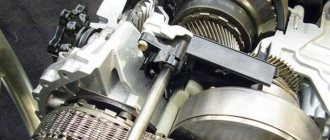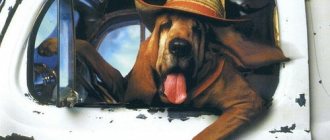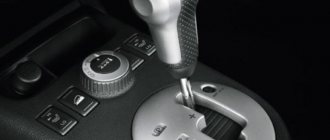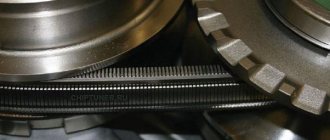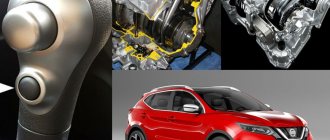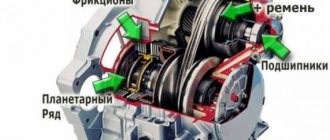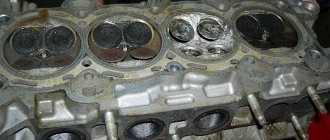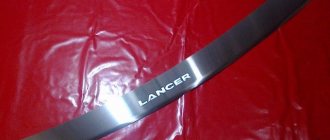One of the transmission options for the Mitsubishi Outlander is a CVT. Its reliability and durability are controversial among owners. This is due to the fact that the service life of a continuously variable transmission is directly related to compliance with operating recommendations.
For example, an untimely oil change in a variator can cause serious problems, the elimination of which will require large financial investments.
Use of a variator on Mitsubishi Outlander cars
The Outlander uses a Jatco JF011E variator. Since May 2014, the Mitsubishi Outlander 3 has been using the Jatco JF016E CVT. According to Mitsubishi's internal classification, the continuously variable transmission on front-wheel drive vehicles is called F1CJA. On all-wheel drive Jatco vehicles, the JF011E is designated model W1CJA. More detailed information about which CVT is installed on the Mitsubishi Outlander is presented in the table below.
Table - Modifications of continuously variable transmission on Mitsubishi Outlander
A feature of the Mitsubishi Outlander CVT modification is the lack of interchangeability. There is a difference at the level of hydraulic units, seats and ECUs. Therefore, when purchasing a contract transmission, it is extremely important to pay attention to the modification.
The Jatco JF011E variator has good performance characteristics and high reliability. Therefore, it has found application on cars of other brands. For example, it is found at Renault, where it is assigned the model FK0/FK8. Jatco JF011E is installed on both Dodge and Jeep. There it is called CVT/CVT2. The transmission has gained wide popularity from the Nissan company. According to the internal classification, the variator is designated RE0F10A/B/C. You can get acquainted in more detail with the cars on which the Jatco JF011E is installed in the table below.
Table - List of cars on which Jatco JF011E is used
Typical diseases of the variator on Outlander
CVT for Outlander xl and its malfunctions
The standard CVT disease on the Outlander is regular overheating, especially in the summer. This is due to the fact that the Outlander does not have any kind of transmission cooling system. Therefore, when operating from 100 kilometers, it gets very hot. Therefore, the possibility of significant damage increases after several 10 thousand mileage.
The transmission may hum when the machine is running. More precisely, the bearings have failed. A popular problem is a stretched V-belt. However, these are common illnesses for all CVTs.
Main technical characteristics
The CVT has gained the greatest popularity on cars equipped with 2-liter power plants. Also, a continuously variable transmission is sometimes used in conjunction with a 2.4-liter engine. You can find out in more detail the main parameters of the Mitsubishi Outlander from the table below.
Table - Technical characteristics of Mitsubishi Outlander with CVT
| Index | Meaning | |||
| Engine volume, l | 02.04.2019 | 2.0 | 02.04.2019 | 2.0 |
| Power, hp | 170 | 147 | 167 | 146 |
| Fuel type | petrol | petrol | petrol | petrol |
| Fuel consumption per 100 km: | ||||
| in the city | 12.06.2019 | 10.06.2019 | 10.06.2019 | 10.03.2019 |
| on the road | 07.05.2019 | 7 | 06.04.2019 | 06.01.2019 |
| Acceleration to 100 km/h, s | 10.08.2019 | 12.03.2019 | 10.05.2019 | 12 |
Mitsubishi Outlander CVT: CVT, pros and cons
The popular mid-size crossover Mitsubishi Outlander received a CVT transmission in 2007.
More precisely, the Outlander XL version was first equipped with a CVT transmission at that time. It should be noted that from the moment the CVT variator appeared on the Outlander, a large number of disputes immediately arose among car enthusiasts, which continue to this day, even taking into account the release of new Outlander models. The main reason for the disagreement is the controversial reliability of CVT gearboxes, their maintainability and the general feasibility of installing them on a crossover instead of the time-tested hydromechanical automatic transmission. Next, we will look at what features the Outlander CVT transmission has, as well as what advantages and disadvantages the box has on different generations of Outlander CVT.
Oil selection and filling volumes
The manufacturer officially recommends using exclusively DIA QUEEN CVTF-J1 or DIA QUEEN CVTF-J4 oil. Since the variator is also used by other automakers, there are other suitable lubricants:
- PSA 9735.EF;
- Nissan CVT NS-2;
- MOPAR CVTF + 4;
- ELF ELFMATIC CVT.
All of the above lubricants are manufactured using identical technologies at the production facilities of Total (ELF) and Idemetsu. Therefore, oils have similar properties, which is confirmed by numerous reviews from car owners.
The amount of oil required depends on the method of changing it. The table below describes the most popular methods.
Table - Required amount of oil depending on the method of changing it
| Way | Required volume, l |
| CVT filling volume according to documentation | 07.01.2019 |
| Replacement using a special device | 10.12.2019 |
| Partial replacement with removal of the pallet | 04.06.2019 |
| Draining oil through a special hole and then refilling it without removing the pan | 03.04.2019 |
The most preferred method of changing the oil is the method of removing the pan. This is due to the fact that at its bottom there are two magnets that catch metal shavings. Changing the oil without removing the pan is recommended only during the first maintenance. It is generally undesirable to use a special device to displace lubricant. It breaks off abrasive particles and spreads them throughout the variator. This significantly reduces the resource of the Mitsubishi Outlander continuously variable transmission.
Types of automatic transmission on Outlander
Let's find out which "automatic" will leave the best impressions.
The hydromechanical transmission used in the Mitsubishi Outlander is a descendant of the automatic transmissions installed in Cadillac cars in the mid-20th century. The hydromechanical gearbox technically has much more difficulties. The variator was manufactured much earlier, but that period did not allow it to become a durable and cost-effective replacement, so hydromechanics has a monopoly on the market for more than half a century. Rising prices push automatic transmission manufacturers to resort to innovation every time. Transformers began to be mechanically blocked. When electronic control appears, the shift gear is selected individually, taking into account the manner of movement and the dimensions of the car. For those who like fast driving, gears are switched at high speeds, and for those who like measured driving, fuel consumption is reduced. The hydromechanical gearbox of the Mitsubishi Outlander makes a good impression, but is the most voracious. If you decide to choose a variator instead of a hydromechanical gearbox, it is worth noting the disadvantages that limit the places where they can be used. If the zone requires high torques, then it will not be suitable for a variator. Considering the operation of the variator, there are no comments. An engine with a CVT gearbox operates more economically, but loses in dynamics. The modernized Mitsubishi Outlander is pleased that during acceleration there is no howl of the variator, and it has also become more durable.
The Mitsubishi Outlander XL has a six-speed gearbox, which works well with the three-liter 220-horsepower engine. The car accelerates to one hundred kilometers in 9.7 seconds, if this does not impress you, you will like the powerful traction. The efficient gearbox shifts smoothly, which allows engine braking, and behaves measuredly and maneuverably on the road. For slippery road surfaces, the switch to manual mode is set. By moving the automatic transmission selector to the left and pressing the levers on the steering wheel paddles, you can switch to this mode. The transmission on the Mitsubishi Outlander is a reliable all-wheel drive transmission. Torque in normal driving is transmitted only to the front wheels, and the rear wheels are connected via an electronically controlled friction clutch based on a computer signal. When overcoming a difficult road surface, the clutch can be forcibly locked using mode 4 WD Lock. The first thing you will notice about the movement is ease of control.
The developers perfectly combined the engine and transmission, and the impenetrable suspension. Experiments with speed were completed “excellently”. The engine picks up speed briskly and does not pay attention to the ruts, holes and roughness of the track. For many buyers who don't want to drive an SUV, the CVT is an excellent choice. This Japanese beauty has few competitors. He demonstrates the correct and good Outlander SUV; it does not distract, as his colleagues do with their external charisma from the primitive drive. Mitsubishi Outlander is a car for active drivers, for the energetic you!
› Features of automatic transmission
When driving away (with the engine running), fully depress the brake pedal before engaging gear to prevent the vehicle from starting to roll slowly. The car will start moving as soon as the gear is engaged. Be especially careful when the engine is running at high speeds (at high idle speeds or when the air conditioning is running); You should only release the brake pedal when you are ready to start moving.
Press the brake pedal only with your right foot. Using the left foot for this purpose slows down the driver's reaction in the event of an emergency.
To avoid sudden acceleration, do not greatly increase engine speed when moving the selector lever from the “N” or “P” position.
Acceleration when overtaking
To quickly accelerate the vehicle when overtaking with the automatic transmission selector in “D” (“Drive”) position, depress the accelerator pedal all the way. In this case, it will automatically switch from fourth gear to third, from third to second or from second to first in accordance with the speed of the vehicle; in this case, there is no need to switch the gear selector from position “D” (“Drive”).
Movement on the rise
The transmission may not upshift if the electronic control unit determines that the vehicle's current speed cannot be maintained when upshifting.
To ensure a smooth ride, if you release the accelerator pedal while driving on an incline, the transmission may not shift to a higher gear. This is normal, since the electronic control unit temporarily prevents gear shifting in this operating mode. When the top of the climb is reached, the automatic transmission switches to normal gear shift mode.
Driving downhill
When driving down a steep slope, the electronic control unit will automatically engage a lower gear. This function allows you to enhance the efficiency of engine braking, thereby reducing the need to use the vehicle's braking system.
Stop
During short stops, for example, before a traffic light at an intersection, you can leave the gear in place and hold the car in place using the service brake (by pressing the brake pedal). For longer stops with the engine running, move the automatic transmission selector to the “N” (neutral) position.
Do not press the accelerator pedal unnecessarily when braking the vehicle. In this case, the car may accelerate unexpectedly if the selector is not in the “P” (“Park”) or “N” (“Neutral” position). When starting off, make sure that the selector is in the “D” position.
Parking
When parking the vehicle, first of all, stop it completely and fully raise the parking brake lever. Then move the automatic transmission selector to the “P” position. If you are going to leave the vehicle unattended, turn off the engine and remove the ignition key.
Mitsubishi Outlander is equipped with both manual and automatic transmissions, while the more economical and dynamic option is the Mitsubishi Outlander automatic transmission
. However, during operation, its main parts are subject to wear, which leads to the need to restore the box. This process begins with a thorough diagnosis. This is done using special equipment. Aulander is characterized by the use of CVT variators. They are distinguished by good environmental performance, efficiency and smooth running. But their unreliability and constant failures constantly force them to turn to specialists. This is due to the powerful, and it is with this indicator that the durability of the variator correlates.
The design of the variator in a simplified format is presented in the form of two pulleys, with a belt thrown over them. This design ensures a smooth change in the gear ratio, which in turn allows for a smooth ride of the car. The weak point where Mitsubishi Outlander gearbox malfunctions
, is the belt, or more precisely, the materials from which it is made. In order for the variator to please the owner with long and uninterrupted operation during its operation, it is necessary to adhere to the instructions regarding its maintenance. Another disadvantage of this box is the presence of a short interval, which is necessary for maintenance.
To avoid frequent repairs, it is necessary to regularly change the transmission oil; otherwise, oil starvation will inevitably lead to abrasion of the teeth related to the planetary mechanism, which will turn the liners over.
List of required tools
In order to replace the lubricant in the Mitsubishi Outlander 3 variator, you need a list of tools from the table below.
Table - Tools and materials required for changing the oil
| Tools and materials | Note |
| Cleaner | To remove traces of oil from the pan, as well as to wash magnets and the coarse filter |
| Head | "at 10", "at 19" |
| Vorotok | With extension and ratchet |
| Watering can | For filling grease |
| Tara | Capacity from 5 liters, quite wide |
| Measuring containers | To determine the amount of oil drained |
| Rags | To eliminate grease leaks and clean contaminants |
Basic faults
Now let’s look at what problems and malfunctions affect the lifespan of CVTs in the Mitsubishi Outlander:
The video on the channel Ambulance for your unit shows the process of repairing the Outlander transmission.
Troubleshooting
You can check for errors in the operation of the gearbox using computer diagnostics. To do this, you can contact a service station or try to do everything yourself. To determine the problem, you will need a laptop with diagnostic software, as well as an adapter to connect to the diagnostic connector. Having connected to the plug, the verification utility is launched, which reads all the fault codes remaining in the memory of the control module. Using these codes you can decipher the problem.
How to solve problems with the checkpoint:
User Alexander Stepanov in his video spoke about problems in the operation of Mitsubishi Outlander CVT gearboxes.
Typical problems identified during operation
One of the main problems of the variator on the Mitsubishi Outlander is its constant overheating during the summer heat. As the temperature increases, significant wear occurs on the elements of the continuously variable transmission and it may fail.
To avoid costly repairs caused by overheating, car owners install an additional cooling radiator. It allows you to reduce the temperature. On vehicles equipped with additional radiators, an increase in the oil fill volume of the continuously variable transmission should be taken into account.
If you follow the oil change schedule and adhere to other recommendations of the car manufacturer, the belt can last more than 400 thousand km. Otherwise, it may wear out and stretch. The belt begins to scratch the cones and slip.
The Jatco JF011E variator uses two modifications of belts. The simpler Bosch 901066 has ten tapes. It has a lower price. The Bosch 901047 reinforced belt has twelve belts in its design. This is why it is 6-10 thousand rubles more expensive than a simple belt. Moreover, both chains are completely interchangeable.
The most expensive CVT breakdown is associated with damage to the cones. Their wear leads to the appearance of defects in all associated elements. Therefore, the situation often arises that if the cones are damaged, it is more profitable to buy a new or contract transmission than to carry out repairs.
A common problem with the Mitsubishi Outlander variator is the failure of one or more shaft bearings of the continuously variable transmission. Symptoms of a malfunction are hum, noise and other extraneous sounds that come from the unit. In this case, it is highly undesirable to delay repairs. Failure of the bearings leads to misalignment of the cones, which causes severe wear. Even short-term use of the car in this case leads to a significant increase in the cost of repairs.
The stepper motor also causes variator breakdowns. The electric motor itself has a long service life, but its foot, which controls the position of the cones, breaks off quite often. Because of this, the variator loses its ability to change the gear ratio.
Due to overheating, the rotation speed sensor fails. Replacing it is rarely accompanied by difficulties.
In the absence of timely oil changes, the line begins to clog. The throughput of the solenoids decreases, and the load on the oil pump increases, which negatively affects its service life.
Driver reviews
We invite you to read reviews from owners of 2013 Mitsubishi Outlander crossovers.
| Positive | Negative |
| I bought an Outlander produced in 2013, I didn’t know anything about the variator at that time - well, “automatic” and “automatic”, but it behaves great! Maybe it’s because I’ve driven a manual all my life and switched to an elite crossover, but I’m happy with everything! The CVT is absolutely unpretentious; the only thing it needs is to change the oil on time. I changed it for the first time after 90 thousand kilometers, I came to the service station, they said - you need to change the transmission fluid every 60 thousand, otherwise it’s kaput. I changed the oil and filter twice, drove 160 thousand km, no complaints yet! | I also decided to leave a review. In general, your variator is complete crap! I often travel around big cities and it seems to me that this unit is clearly not for Moscow or Kyiv traffic jams! In such a dense traffic it is very difficult to change lanes, the variator needs extra time to “get it right”, and even with such dimensions, try to get through. The car was bought in 2013, a year later the reverse gear stopped engaging, I pulled it several times - everything was fine. Although I changed the oil in the box on time, I went to the dealer just in case, then to the service station - neither there nor there could give an intelligible answer why the speed would not turn on. |
| My 2013 Outlander has been used in very rough conditions. I don’t know what the Japanese meant when they wrote in the operating instructions that you can’t drive through the fields, but for two years I went to my dacha (and it’s not on Rublyovka) in the village a la Muho*sk. It’s not just off-road, it’s the real “**** of the world.” And somehow everything is normal! There are no questions, I took care of the gearbox, changed the filter and oil during the process, and everything was just “fire”! Only once, while driving on the highway, a light came on on the instrument panel saying “the variator has overheated” or something like that. Well, I was driving at about 140 km/h at that time. I slowed down to 90 km/h and there were no more problems. | I came here to complain! Today I had to take my 2013 Outlander to a service center. I've only driven 40,000, and it's not even time for an oil change yet. And as I was told, most likely I will have to change the variator. Do not repair, but rather replace, because such gearboxes cannot be repaired! A few days ago I started having jerks when moving, well, they were minor and went away quickly, so I didn’t attach any importance to it. And yesterday I was stuck in a traffic jam and my “iron horse” simply stalled and refused to go. A light with an exclamation mark came on on the instrument panel, but it was written there in English, so I don’t know what it means. I call the service, outline the situation, they tell me: “You can go, it’s okay, it happens that the electronics get stuck.” How to drive it? He couldn't even move! After 10 minutes of trying to start, the car finally started, although before that it was roaring strainedly, then I started moving and after a few minutes it drove normally, as if it had woken up. But the failures and jerks did not end this time. There is no power, when you press the gas pedal it only roars, but does not gain momentum. We took it to an official dealer for repairs, but that’s a whole different story! |
| You just need to keep an eye on your “iron horse” so that there are no problems later. I have a 2013 Mitsubishi Outlander, I did everything as written in the car owner's manual. Starting from timing of oil changes to technology for warming up the engine and gearbox in winter. I can’t say that everything is great: after all, problems can be found in any car, and the car itself is relatively new, but in general everything works with a bang. Do not forget about the instructions - proper operation of the car will increase its service life. | I bought this crossover in 2013 and wanted to say a few words about reliability. It seems to me that such a concept as “reliability” is alien to the Japanese. After 30 thousand kilometers the first problems began - the air conditioning stopped working. Only the stove blows hot air and that’s it. I went to the dealer and paid 10 thousand to repair something there. After another 15 thousand kilometers, the electronics begin to slow down - either the windows do not rise, then the radio reboots itself, or the headlights blink alternately. Again I went to the official representative. It turned out that there was a break in the wiring somewhere, which is why all the stupidity was happening. Naturally, everything was blamed on me, allegedly due to improper operation. Do you think that's all? No! I changed the oil, everything was as it should be according to GOST - after 60 thousand kilometers, and then my gears stopped turning on! I had to tow it back to the dealer, I almost attacked them with my fists. They took the car and they said the automatic transmission needs to be checked. They gave it back two days later, they said the variator was out of order and had to be replaced. Ha, I haven’t paid the money already. So, the concept of “reliability” between us and the narrow-eyed is far from each other! |
| For almost two years of driving a crossover (Mitsik 2013), once a problem arose with shifting gears, which was successfully resolved by replacing the transmission “consumables”. And when buying from a dealer, I came across a good consultant - he told me everything about the car, all the nuances, as if he himself drove one. And in many ways he was right. The only thing that can ruin this “Japanese” is improper operation. At first it seems - what kind of nonsense is this? And then you realize that the Japanese are not “Zhuzhiks” or “UAZs” for you, you need the right approach to them, and not anyhow. If the instructions say so, then that’s the only way to do it. And even more so, in the event of a breakdown, you can’t trust repairs to untested people at a service station, otherwise they’ll screw things up there that you can’t fix later! | I also decided to leave my review. First the good stuff, because it won't last long. I'm pleased with the roomy interior and trunk - just three bags of potatoes fit in there. This is where the advantages of Outlander end! Now let's move on to the disadvantages. Very expensive service from official dealers during the warranty period! Why the hell should I even pay for Japanese joints? I argued with representatives for a long time about this, but they still “knock money” out of me! Spare parts for cars are also not cheap, I, of course, compare not with a VAZ or a Daewoo, but with cars of the same class. Disgusting brakes - before that I rode a Lancer, and they have the same braking system with the Outlander, but if I covered about 40 thousand km on Lancer pads, here their service life did not even exceed 20 thousand. Separately, about the variator - I didn’t expect to buy such “hemorrhoids” at all. Why do I need an SUV, which, as it turned out later, cannot be used in rural areas? |
| I'm quite happy with my Outlander. I knew firsthand what a CVT transmission was before I bought the car. I want to say that all the stories about off-roading and cold driving are fairy tales! Maybe I drive carefully, but due to circumstances I had to skid on ice, mud, and tow someone else’s car halfway across the city, and drive quickly in the cold in the morning to work. And there are no problems. And although it does not behave so actively in a traffic jam, it fully justifies driving on the highway. Before that, I had a Nissan with a regular automatic transmission, and I also bought a new one from the dealership. So there were a lot of problems with this “automatic machine”! Either the oil began to leak, then the gears did not turn on, then it was running wildly while driving, or something else. All the problems were solved a year later, when I finally “got” the dealer and instead of repairing them, they changed the gearbox for me. In the case of Outlander, everything is exactly the opposite. It’s hard to say anything bad about the CVT and the car as a whole. | A year ago I bought a used 2013 Outlander. The previous owner, apparently, had no idea what a CVT was or how to handle it. Its mileage was 70 thousand km, so I decided to immediately change the oil. I don’t know how, but there was about 3 mm of dirt at the bottom of the automatic transmission! Metal shavings which, apparently, were a product of wear of some parts. In general, I took the car to the service station, they did a complete flush of the transmission system, I thought it was worth doing this just in case. I drove about 50 thousand more km on it. Everything seems fine, but overheating of the CVT is generally a disaster, especially in the summer. I don’t drive very hard, but overheating appears already at a speed of 100 km/h. It is not clear why, but the manufacturer discontinued the installation of a variator radiator and the CVT cooling system. I contacted the official dealer, they began to list problems that could be associated with overheating and the incredible amounts that repairs would cost. I thought, I’d rather drive up to “hundreds” than pay that kind of money. |
| We bought an Outlander for our family the year before last. It was not used very often (during this time the car covered 50 thousand km). We only went to visit our parents on the other side of the city and several times on vacation at the seaside. Maybe it's not time to complain yet, but I have no complaints against the manufacturer. At first, only the seats seemed uncomfortable, but over time we got used to it, we took turns riding - my wife and I. So even she (everyone knows that a car driven by a woman breaks down much more often) had no problems. I repeat, maybe it’s not time for this yet, the machine is relatively new. | |
| I bought the car off the showroom floor. The first thing I didn't like was the stiff suspension. It's very tough. I had a “nine” before, so it went through all the holes and bumps much smoother, and the SUV turned out to be a real sissy! I was also disappointed by the consumption, which is much higher than stated. On the highway, my “iron horse” consumes 9 liters, and not always, more often - 10. But overall I’m happy with the car, it’s a very dynamic car, I change the oil and filters in the box on time, and there are no problems with its operation. |
CVT overheating lamp on the instrument panel
As you can see, owners have different attitudes towards certain problems that arise when operating the Mitsubishi Outlander.
As practice shows, most breakdowns could actually be avoided if the car was used correctly. In particular, this applies to the variator. This unit is hypersensitive to heavy loads and improper use.
Review of feasibility of repairs
The Jatco JF011E continuously variable transmission has good maintainability. Therefore, if breakdowns occur, in most cases repair is recommended. An exception is a CVT with a mileage of more than 400 thousand km or with serious damage to most elements, including cones.
Contract CVTs in retail cost from 50 thousand rubles. In normal condition, a supported unit can be found for 100 thousand rubles. A new continuously variable transmission from an official dealer costs from 220 thousand rubles.
Checking the CVT before buying a car
Why the clutch slips, diagnostics and main faults
When buying a used car with a CVT continuously variable transmission, special attention should be paid to the gearbox. Even minor CVT repairs cost owners a pretty penny
After reading this article, you can formulate a step-by-step action plan for checking a car with this gearbox in your head. You will have the opportunity to reduce the base price of the car in case of minor deviations or even refuse to buy it altogether. So let's get started.
Car mileage
Mileage is the main criterion that you should pay attention to. A mileage of 120 thousand is considered high; if the owner looked after the car, then the ATF fluid in the box should have been changed twice
If you are not sure that the tachometer has a real number, you should check the mileage of the variator using a special scanner connected to the CVT transmission ECU. During diagnostics, you can also find out whether there were errors and what they were, whether the oil aging parameter was reset, the pressure in the system, and much more.
Check the oil level and condition
The oil level in the variator is checked with a hot or cold box and has two marks on the dipstick. The level is checked with the car running. Before checking, you need to press the brake and hold the selector in each position for 5-10 seconds. Below is a drawing of a probe in which two intervals are visible: the hot and cold zone of the marks. The oil level should be between the marks, depending on the temperature of the box.
The oil must be light, otherwise you will have to replace it yourself (the price tag for this work with materials is approximately 15 thousand or more), the ATF should not contain inclusions of metal shavings (if the particles are visible to the naked eye, then the oil change took place without removing the oil pan, and therefore: filters were not changed, magnets were not cleaned). Also, the oil should not have a burning smell, and overheating, as everyone knows, does not extend its service life. After purchase, be sure to replace the transmission fluid by removing the crankcase as described in this manual.
Has the variator been repaired?
After checking the oil level and condition, you need to pay attention to the box fastenings. The factory marker on bolts and nuts must be present
Pay attention to the presence of nicks and abrasions on the variator mounts. Compare the general condition of the engine compartment and gearbox; contamination should be uniform. If repairs were carried out, find out from the former owner the cause of the malfunction, and also ask for documents on the work done.
Check in motion
The deepest misconception about checking the variator is driving through an obstacle (curb) from zero speed; climbed up means the transmission is in order, but this is not so. The cones in this case remain in their previous position. At zero speed, the high-pressure oil pump does not move them apart, so you need to reach the minimum speed to overcome the obstacle. It is recommended to check the box both cold and hot; as a rule, kicks and jerks in some cases go away when the CVT warms up.
Be sure to ask the seller for a test drive of the car, in which you can feel all the shortcomings of this unit
It is also advisable to take a ride with the seller and pay attention to his driving style. Box bearings should not howl in all operating modes
Happy shopping! And don’t forget, you can reduce the final price of a car with a CVT transmission for any deviation indicated in this article!
Strengths and weaknesses of the variator
The advantageous feature of this gearbox is its ease of operation. Thanks to it, the driver can concentrate as much as possible on the road. This version of the gearbox is widely used on SUVs. Among the advantages also stand out:
- speed changes are carried out quickly;
- quick acceleration to hundreds;
- no shocks from the gearbox are felt;
- saving fuel.
CVT transmission diagram
Among the weak points of cars with a CVT gearbox, it can be noted that not every car service center undertakes to repair the CVT on Mitsubishi. In addition, it is not always possible to purchase the components needed to return the box to working capacity. It also helps reduce the operating life of the variator:
- incorrect handling of the car by the driver (frequent off-road driving);
- use of low quality fuel;
- missed maintenance.
Thus, the CVT provides comfort to the driver while traveling. The installed variator on the Outlander XL model has a working life almost equal to the service life of the entire vehicle. How long does a Mitsubishi Outlander with a CVT drive? The average service life of the CVT on Outlender is 200,000 km. This level remains acceptable for many motorists.
